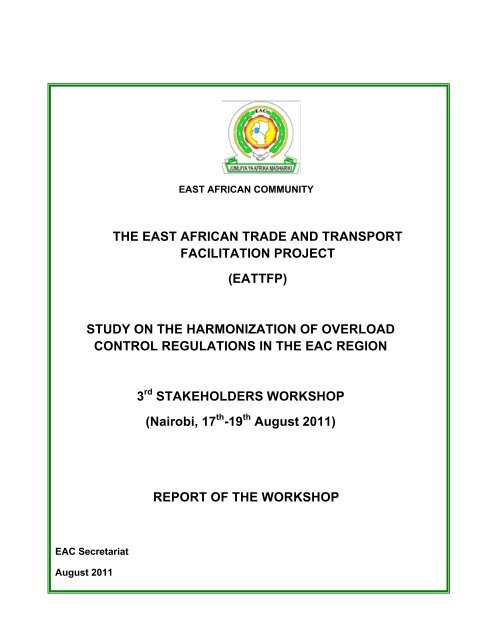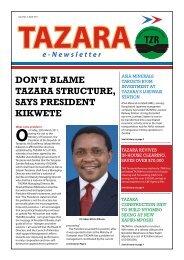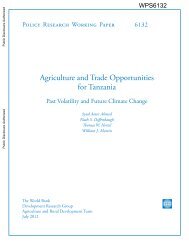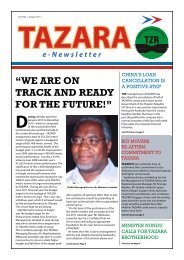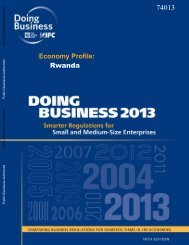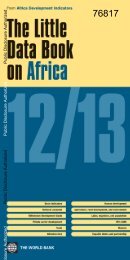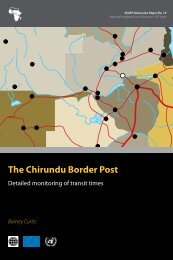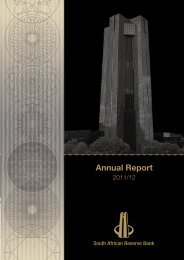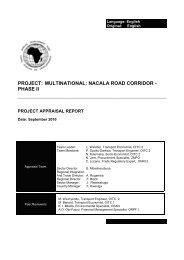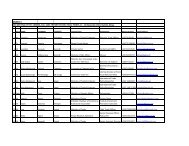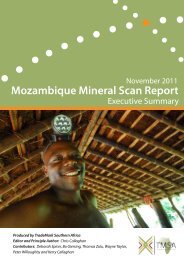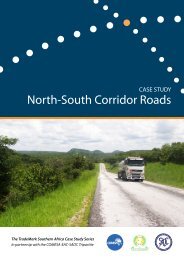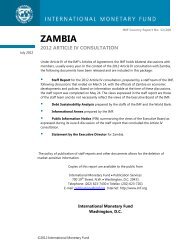Report | 3rd Stakeholders Meeting - TradeMark Southern Africa
Report | 3rd Stakeholders Meeting - TradeMark Southern Africa
Report | 3rd Stakeholders Meeting - TradeMark Southern Africa
- No tags were found...
Create successful ePaper yourself
Turn your PDF publications into a flip-book with our unique Google optimized e-Paper software.
EAST AFRICAN COMMUNITYTHE EAST AFRICAN TRADE AND TRANSPORTFACILITATION PROJECT(EATTFP)STUDY ON THE HARMONIZATION OF OVERLOADCONTROL REGULATIONS IN THE EAC REGION3 rd STAKEHOLDERS WORKSHOP(Nairobi, 17 th -19 th August 2011)REPORT OF THE WORKSHOPEAC SecretariatAugust 2011
STUDY ON THE HARMONIZATION OF OVERLOAD CONTROL REGULATIONSIN THE EAC REGION3 rd STAKEHOLDERS WORKSHOP(Nairobi, 17 th – 19 th August 2011)REPORT OF THE WORKSHOP1 BACKGROUND1.1 Convening of the <strong>Meeting</strong>The 3 rd <strong>Stakeholders</strong> Workshop for the Study was held as per the Terms ofReference and the work plan. The objective of the Workshop, held at thePermanent Secretaries Level, was to present to the Permanent Secretaries asummary and key study issues, reach consensus on outstanding issues, reviewrevisions the JICA Study Team will make in preparing the Final <strong>Report</strong>, to besubmitted to the EAC Secretariat on 29 th September 2011 and agree on a roadmap for subsequent activities.The Study has been funded by the Japan International Cooperation Agency(JICA) through a grant to the EAC Secretariat and conducted by PADECO Co.,Ltd. of Japan.1.2 ParticipantsThe <strong>Meeting</strong> was attended by Permanent Secretaries and/or theirrepresentatives from the five Partner States. The list of participants is attachedas Annex I.1.3 Constitution of BureauIn accordance with the EAC Rules of Procedure, the meeting was chaired by Mr.Willy Madirisha, Director, Internal Transport, Ministry of Transport, Public Works,and Equipment, Republic of Burundi, while Ms. Irene N. Musebe, SeniorAssistant Director, Ministry of East <strong>Africa</strong>n Community, Kenya, was theRapporteur. The EAC Secretariat and the JICA Study Team assisted theRapporteur in the preparation of the <strong>Report</strong> of the Workshop.1.4 Adoption of the Agenda and ProgrammeThe agenda and programme were adopted and are hereto attached as Annex II.1
1.5 Opening RemarksChairperson of the WorkshopThe Chairperson noted that the Workshop was last for the stakeholders and thatthey should take full advantage of it to enrich its outcomes and reach consensuson outstanding issues. He observed that agreement had been reached on 21 of23 issues (see Annex III), with gross vehicle mass and the use of interlink trucksthe only outstanding issues. He welcomed the Permanent Secretaries to assist inthe resolution of the outstanding issues.He noted that four Partner States (except Kenya) had agreed on a 56 tonnegross vehicle mass (GVM) limit (for seven axles), while Kenya had agreed on aGVM limit of 52 tonnes (for six axles). Also, that four Partner States had agreedon the use of interlinks up to 22m, without the requirement for special permits,while Kenya had agreed to accept interlinks only with special permission. Hecalled on the meeting to work towards a consensus on these issues in the sameway that they had agreed on 21 out of the 23 issues in the study.He wished the meeting good deliberations.Remarks from the Leaders of DelegationsThe heads of the delegations made the following introductory remarks.BurundiThe leader of the Burundian delegation Mr. Pierre Bayihishako, Director of RoadPlanning, Ministry of Transport, Public Works and Equipment, observed that theWorkshop was the last meeting/workshop before the 9 th TransportCommunications and Meteorology Sectoral Council meeting and hoped that aconsensus will be reached on outstanding issues. He observed that Burundi,being a landlocked country, had a keen interest in the outcome of the axle loadharmonisation process as it had major implications on the cost of transport.KenyaThe representative of the Leader of Kenyan delegation Mr. Alfred Kitolo, Director,Ministry of East <strong>Africa</strong>n Community, welcomed the delegations to Kenya. Henoted that the Partner States had come a long way through task force meetingsand stakeholders workshops, clearly indicating that the countries are willing towork all the way until the “final product” is reached. He expressed the hope thatprogress could be made on the issues before the Workshop over the next fewdays.TanzaniaThe leader of the Tanzanian delegation, Eng. Dr. John Ndunguru, DeputyPermanent Secretary, Ministry of Works, thanked Kenya for hosting the2
Workshop. He also thanked the EAC and JICA, for organising it. He observedthat Tanzania was in agreement that the two outstanding issues should beresolved so that the region could reduce the cost of transport which is stillconsiderably high. He further noted that with the harmonisation of the axle loadregulations, trade between the Partner States will increase. At the same time, herooted for effective measures to save on the developed infrastructure in thePartner States.UgandaThe leader of the Ugandan delegation Mr. Charles Muganzi, PermanentSecretary Ministry of Works and Transport expressed his delegation’s gratitudeto the Republic of Kenya for hosting the Workshop and to the EAC and JICA forthe Workshop preparations. He noted that Uganda had agreed on the twooutstanding issues and was committed to work with all the Partner States toreach full consensus on the harmonisation of axle load regulations in the EAC.RwandaThe leader of the Rwandan delegation Dr. Elias Twagira, Director General of theRwanda Transport Development Agency, thanked the Republic of Kenya forhosting the meeting and the JICA Study Team for their technical contributions.He noted that on the two outstanding issues, the Republic of Rwanda hadreached agreement on them and hoped that full consensus will be reachedduring the Workshop. He echoed the sentiments of Burundi that his country wasalso landlocked and suffered high costs of transport as a result of differentiatedaxle loading requirements.Japan International Cooperation AgencyMr. Masaaki Kato, Chief Representative, JICA Kenya Office, expressed JICA’sgratitude to the Permanent Secretaries and their delegations for attending theWorkshop.He noted that the EAC through its Partner States and the Secretariat since itsfounding in July 2000 had made concrete progress through establishment of aCustoms Union in 2005, the joining of Rwanda and Burundi in 2007, andcommencement of a Common Market in July 2010, with further steps towardregional integration ongoing.He promised Japan’s unwavering commitment to <strong>Africa</strong>n development throughthe Tokyo International Conference on International Development (TICAD), evenduring the current difficult times in Japan due to the 11 th March 2011 earthquakeand related disasters. He informed the meeting that facilitating regional transportthrough a corridor approach, including one-stop border posts (OSBPs), is aprimary commitment of Japan. He appreciated the close cooperation with theEAC Secretariat in pursuing harmonization of regional rules and regulations on3
axle load control; the development of OSBP Bill and the ongoing transformationof the two stop border posts to improve transit transport.He wished the meeting fruitful deliberations.Representative of the Deputy Secretary General, Planning andInfrastructure, EACMr. Philip Wambugu, Director, Infrastructure, EAC, presented the openingremarks on behalf of Dr. Enos S. Bukuku, the Deputy Secretary General,Planning and Infrastructure, EAC.Dr. Bukuku thanked the Republic of Kenya for co-hosting the Workshop and thePartner States for their steadfast support in the policy harmonisation processesthat the EAC Council of Ministers had approved under the infrastructure subsectors. He underscored the ongoing harmonisation process covering the onestop border posts operations and the axle overload control as crucial towardsreducing the cost of transport in the region.He observed that the efforts to harmonise axle overload control had been aconcern of the Council of Ministers for the last ten years and efforts to harmonisethem had not borne fruits as yet. He, therefore, expressed great hope that theWorkshop will work towards achieving a consensus on all outstanding issues inparticular agreeing on the gross vehicle mass and the use of interlinked vehiclesin the region.He reminded the Workshop that the Protocol on the establishment of the EACCommon Market gives the Council of Ministers a window of three years (nowless than two years) to harmonise all the remaining regulations under transport,hence the need for speedy agreement on the way forward for the axle loadregulations.He wished the meeting fruitful deliberations. The full text of the statement of theDeputy Secretary General, Planning and Infrastructure, EAC, is attached asAnnex IV.2 Presentation of the Executive Summary and Key Study IssuesMr. Yuichiro Motomura, JICA Study Team Leader/Transport Planner, presentedan executive summary and key study issues, including an overview of findingschapter by chapter. The PowerPoint for Mr. Motomura’s presentation ispresented in Annex V.Rwanda noted that the presentation was well received and it had no pendingissues on the JICA Study Team’s work.4
Tanzania stated it had no pending issues but observed that with the presence ofpermanent secretaries, there was an opportunity to have a closed door meetingto have a common stand.Uganda observed that we are moving from each country setting it owns limits, toharmonized standards, and this is the core issue for the Workshop. We shouldnow move to a regional position.Kenya stated that the summary captures the issues in the larger report.Burundi stated that the presentation was well received. They stated that theywould provide information on paved and unpaved roads for Table 3-5 by 22 ndAugust 2011. Also, they stated that the Central Corridor through to Burundishould be properly shown in Figures 3-1 and 4-6 in the report.Uganda noted the need to check on manufacturers’ recommendations regardingthe treatment of liftable axles.The JICA Study Team Leader stated that the Team will prepare the Final <strong>Report</strong>taking into account all of the comments during this Workshop.EAC stated that the detailed presentations will allow for more detailedclarifications.3 The Outstanding Issues3.1 DiscussionAs indicated in the opening discussion, there were two outstanding issues: (i)relating to gross vehicle mass limits, on which four countries have agreed on alimit of 56 tonnes for seven axles, but which Kenya supports a limit of 52 tonnesfor six axles; and (ii) relating to the use of interlinks without conditions.The Study Team explained its finding why increasing the GVM limit from 48tonnes to 56 tonnes would not make a significant difference on bridges. Themaximum bending moment for a Case A, 48 tonnes, and Case B, 56 tonnes,were examined. In terms of combined force (the maximum stress on bridge), thedifference between the two cases was only 3.8% (i.e., within the margin of errorof civil engineering construction), even though the tonnage would be increasedby 16.7%. The increase in mass makes little difference in terms of bridge safety.Kenya noted that permanent secretaries were invited to address this issue tobridge divergences. They suggested a closed session discussion to givedirection on the issue.5
The Director General, Customs and Trade at EAC, and a representative ofSecretary General of EAC, stated that he would like to see this issue sorted outbecause it is one of the critical matters governing trade facilitation in the region.Uganda observed that the presentation addressed the engineering aspect, butnot necessarily the sociological aspects.Tanzania and Rwanda urged finishing this debate and reaching a conclusion.Moving from 48 tonnes or 52 tonnes to 56 tonnes only has a minor difference inimpact on bridges.Mr. John Patrick Donovan, <strong>TradeMark</strong> <strong>Southern</strong> <strong>Africa</strong> (TMSA), funded by theUnited Kingdom Department for International Development (DFID), notedsynergies between work in <strong>Southern</strong> and Eastern <strong>Africa</strong>. In the documentpresented by the JICA Study Team there are several references to a CSIR study;he asked that it mention that TMSA funded the study, which is on their website.(The JICA Study Team appreciates the suggestion and will make the change inits Final <strong>Report</strong>.) The TMSA-assisted CSIR report, presented at a 14 th June 2010conference in Lusaka, covered a number of topics in connection with interlinks(e.g., lane width, turning circles). It recommended that all countries allowinterlinks to operate on their roads, when operated under limits agreed by thethree RECs. They are more payload efficient and result in lower volumes onspecific routes.Tanzania stated that the issue is a purely an engineering one. The difference instress from 48 tonnes to 56 tonnes was found by the JICA Study Team to be only3.8%. When Tanzania increased its GVM limit to 56 tonnes they ran simulationmodels, and carried out bridge capacity ratings and found that 56 tonnes wouldbe adequate for their network. If an increase of 3.8% does not cause bridgefailure, the answer is straightforward. If some bridges are found to be inadequate,then it is possible to look at strengthening those bridges.The JICA Study Team recalled that Kenya previously ran the articulated vehiclewith a quadrem unit, and it was banned because it was damaging the roadpavement. It is important not to confuse it with a 7 axle vehicle configurationspread over 22 m. It is a very different vehicle combination.Burundi stated that a four tonne difference is important for them in reducingtransport fees because they are 2,000 km from Mombasa.The Permanent Secretary, Ministry of Roads, Kenya, stated the problem is notonly with a 56 tonne standard. He suggested that the Workshop think of an axleconfiguration that will give 56 tonnes. The JICA Study Team offered explanationthat although the seven axles could carry up to 62 tonnes, the proposed GVMlimit of 56 tonnes will limit what the axles can carry.6
3.2 Resolution of the Outstanding IssuesA closed consultative meeting to resolve the two outstanding issues was heldamong the respective Permanent Secretaries, technical experts, and officials ofthe EAC Secretariat. Agreement was reached on a 56 tonne GVM standard onseven axles, excluding quadruple axle units. It was also agreed that interlinks willbe allowed on defined corridors of the Regional Road Network without extrapermits. The Permanent Secretaries stressed the need for strict enforcement ofoverload control measures and directed the respective technical experts to effectthese changes.A rapid process will be undertaken to develop a road map and subsequent stepsto assure that agreements are effected within the conditions highlighted. Thisissue can now be brought to the attention of the ministers to harmonize theseaspects and make the regional transport system more efficient.4 Chapter-by-Chapter Review (Discussion, Consensus, and Way Forward)4.1 Introduction (Chapter 1)The PowerPoint for the JICA Study Team’s Chapter 1 presentation is presentedin Annex VI.It was clarified that page numbers in the first column of the comment reply matrixrefer to page numbers in the respective meeting reports.It was clarified that the Final <strong>Report</strong> under the contract, will be submitted by 20 thSeptember 2011. The meeting agreed that a pre-final report incorporating all thechanges will be availed to the Secretariat by 9 th September 2011 for finalapproval before printing.Kenya stated that the JICA study should feed into the component of vehicledimensions in the study undertaken by the Bureau for Industrial Cooperation(BICO) of the University of Dar es Salaam. The meeting agreed therefore, thatthe BICO should develop regulations on vehicle dimensions based on amongothers, the recommendations from the JICA study.4.2 Existing Laws and Regulations (Chapter 2)The PowerPoint for the JICA Study Team’s Chapter 2 presentation is presentedin Annex VIII.Kenya noted that the chapter mainly reviews the existing situation in PartnerStates, particularly legal instruments. They recognize the goal of having a singleregional legal instrument to govern these issues. They suggested preparation ofmatrices showing changes required in the respective Partner State laws andregulations to meet the requirements of the proposed regional EAC Act.7
Kenya cautioned that despite the fact that Partner States had agreed todecriminalize overload offenses, there will be need for further consultationsduring the development of the regulations on this aspect.4.3 The EAC Regional Trunk Road Network and Its Maintenance (Chapter 3)The PowerPoint for the JICA Study Team’s Chapter 3 presentation is presentedin Annex IX.Kenya clarified that the pavement design standards used in Kenya are indeedFrench, while the bridge design standards are British, although borrow from theUnited States and the United Kingdom.Tanzania stressed the importance of the review of the pre-final report.4.4 Existing Charges/Fees/Fines and Strategies for Harmonized Charging(Chapter 4)The PowerPoint for the JICA Study Team’s Chapter 4 presentation is presentedin Annex X.The EAC Secretariat expressed concern at the confirmation that in some PartnerStates road fees do not go to road agencies but to the general treasury. TheSecretariat therefore, suggested that this issue should be dealt with in asubstantive paragraph rather than a footnote so that it can be dealt with as apolicy issue during the preparation of the Memorandum for Ministers.Uganda stated that the overload charges/fees proposed in the Draft Final <strong>Report</strong>were low, compared to the existing charges among the Partner States, and maynot be deterrent enough to fight overloading.Kenya offered a number of specific suggestions on Chapter 4:(i) on p. 4-2, Table 4-1, the figures for the Burundi national road fund shouldindicate currency, and also a USD column for the purpose of comparison wouldbe helpful; (ii) on p. 4-7, Table 4-9, the figures for Kenya Roads Board allocationsare given as projected, but with the financial year ended on 30th June 2011,actual figures could be presented; (iii) weighbridges should be shown in orderfrom Mombasa westwards; (iv) on p. 4-16, there is a discrepancy between textand the pie chart showing revenues collected by the Kenya Roads Board; (iv) onp. 4-18, Table 4-14, showing a comparison of systems for collecting overloadingcharges, the term “budget allocation” looks confusing (it can state where thefunds go or are allocated) and the source could be “tabulation from the JICAStudy Team”.8
Table 4-31, Figure 4-11, presents a flow diagram showing where overloadingfines/fees go. The Study proposal on the utilization of the charges as road leviesmay require a change of its national finance acts.On p. 4-35, Kenya stated that the recommended levels of overloading chargesare too low in relation to current charges/fines imposed by Partner States. Thescale of fines indicated in the report cover up to 5 tonnes overload, and thusthere was need to clarify on what happens if the excess load is over 5 tonnes.Kenya stated that the exponential damaging factor was developed by a studycarried out by the American Association of State Highway Officials in the 1960s,and stated that the study recommended power exponents ranging from 3 to 9depending on the level of overloading and pavement materials. Kenya suggestedthat since there is little difference between 4.0 and 4.5, Kenya recommendedusing 4.5 which has been used by Kenya and Tanzania in their design manuals.The JICA Study team explained that the power law exponent of 4.0 was used inpart because it was based on research by the Council for Scientific and IndustrialResearch (CSIR), which made recommendations for various type of pavements(including 4.0 for granular and asphaltic concrete pavements). However, theFinal <strong>Report</strong> would show the comparison of the results of both factors.Uganda stated that on p. 4-13 the reference to “published roads” should be to“public roads” and the reference to “community” should be to “municipality”. On p.4-14, paragraph 3, the reference to categories of expenditures in “URA” shouldbe to “URF”. Also on p. 4-14, in Table 4-13 the reference should be to financialyear 2010/2011.The JICA Study Team further explained that the actual overload charge is up tothe respective Partner States, but the Final <strong>Report</strong> will present a scientificallyjustified method for determining overload charges. The absolute level of chargesin the Draft Final <strong>Report</strong> was low because it was based on discounted figures,which will be revised to undiscounted figures in the Final <strong>Report</strong>. Nevertheless,the estimated maintenance costs will be based on the ideal as determined by themodel, not actual practice, which is likely to entail higher costs. This issue willform part of the further consultations to be carried out among Partner Statesexperts.Tanzania noted that it would be important to quantify the impacts of GVM onbridges. The JICA Study Team clarified that this would require a fair amount ofwork that outside the scope of the study. The Secretariat clarified that it was inthe process of developing a proposal on bridge capacity assessment along theRTRN.9
Tanzania pointed to some discrepancies in the Draft Final <strong>Report</strong>, e.g., on p. 4-2(4) and Table 3-6 regarding the road networks. They noted that unpaved roadsare presumably not part of the Regional Trunk Road Network, but if they are theywould require special consideration. They requested that the Partner States seea soft copy of the Final <strong>Report</strong> document before it is finalized.The JICA Study Team observed that in the past road user charges have been setin a non-quantitative way, but that SADC is completing a road user charge studythat may form the basis for overloading fees.Kenya pointed out that p. 4-35, subheading (3), refers to the recommended levelof vehicle overloading charges, but Table 4-29 refers to the calculation ofmaintenance costs. They would argue for a clear exposition of recommendedcharges, based on recovery of the cost of damage and a punitive element; if theregion is harmonizing, existing fines could be used as a reference. The JICAStudy Team Leader replied that determining punitive aspects was not a technicalissue, but rather a social and political issue beyond the Team’s scope of work.The table will be revised to show the suggested or relative level of cost recoverycharges, but it will not include a penalty, which is an issue for the social ratherthan the technical or engineering domain.It was suggested that the Partner States could give proposals for ideal fines to beincorporated in the Final <strong>Report</strong>.4.5 Axle Load and Gross Vehicle Mass Limits (Chapter 5)The PowerPoint for the JICA Study Team’s Chapter 5 presentation is presentedin Annex XI.It was clarified that the JICA Study Team would refer to the United States,Finnish, and Japanese bridge formulas in the Final <strong>Report</strong>.4.6 Accommodation of Vehicle Technology Development (Chapter 6)The PowerPoint for the JICA Study Team’s Chapter 6 presentation is presentedin Annex XII.Kenya stated that p. 6-5 of the report includes recommendations on singe tyresthat imply that there will be different axle limits depending on tyre size. Theysuggested basing limits on the lowest size or dimension. Also, they wouldwelcome a method for deriving a limit for an axle with single tyres based on theagreed axle load limits for dual tyres. The JICA Study Team concurred that tyresize is quite a complex issue, and the chart shown was for information purposes.However, wider tyres are being adopted in the region and should be taken intoconsideration at weighbridges. Weighbridge officers have to check tyre sizessometimes.10
4.7 Weighbridges and Their Operations and Management (Chapter 7)The PowerPoint for the JICA Study Team’s Chapter 7 presentation is presentedin Annex XIII.It was noted that p. 7-15, paragraph 2, requires some corrections and additionsto reflect proper procedures on weighbridge verification and calibration.Specifically, it was suggested to remove the word “correct” and replace it with“within the tolerance limits”. The word “masspieces” to be replaced with “standardweights”.4.8 Formulation of a Proposed EAC Regional Legal Instrument (Chapter 8)The PowerPoint for the JICA Study Team’s Chapter 8 presentation is presentedin Annex XIV.5 Summary of Agreed IssuesWith agreement on the two previously outstanding issues (i.e., GVM limits andinterlinks), all 23 issues have now been agreed by the five Partner States, assummarized below:No. Issue Agreed Position(s)1 Overload Fines/Fees/ Charges Partner States agreed to decriminalize overloadingPartner States agreed on fees to be set based on therecovery of road damage costs.(This issue is subject to further consultations duringformulation of regulations)2 Axle Load Limits 10 tonnes (single), 18 (tandem), and 24 tonnes(tridem)3 Gross Combination Mass (GCM) Limit Partner States agreed to 56 tonnes maximum on sevenaxles and no quadruple axle groups4 Use of Bridge Formula Agreed5 Dimensions of vehicles To be further analysed by the study on harmonizationof vehicle dimensions under the Tripartite and BICO6 Use of drawings as guidelines in the Agreedadopted regulations7 Mass limits for super single tyres Partner States agreed in principle to the 8.5 tonnes for385/65R22.5 tyres, provided the weighbridgesoftware can be programmed to detect the differenttyres8 Super Single Tyres (way forward) Further verification required by BICO9 Liftable Axles Accepted if accompanied by a dead man’s switch, oron air suspension, or with an automatic dropdownwhen loaded.10 Vehicle with tandem steering axle on Superseded by acceptance of 56 tonnes.drawbar trailer (Dolly)11 Interlinks (B-doubles) Partner States agreed on the use of interlinks asdetermined by designated routes and length of 22m.12 Self Regulation Partner States agreed to promote self regulation in theEAC region13 Types of weighing devices (use ofportable/mobile scales as enforcementdevices or as screening devices)Partner States agreed to allow use of portable/mobilescales for enforcement subject to accreditation11
No. Issue Agreed Position(s)14 Types of weighing devices (choices ofweighbridges can be traffic related)Appropriate types to be selected based on trafficvolumes15 Location of weighbridges To be determined by regulations in the regional legalframework16 Management of weighbridges(involvement of the private sector)To be determined by regulations in the regional legalframework17 Weighbridge operations and procedures Partner States agreed to develop and use harmonizedoperational manuals, weighbridge certificates,networking and auditing18 Mass tolerance on axles and GVM Agreed as 5% on axles and no tolerance for GVM.19 Weighbridge verification = x months Partner States agreed on weighbridge verification andcalibration at least every 12 months depending ontraffic flow20 Weighbridge auditing at least every xmonthPartner States agreed on weighbridge auditing at leastevery 12 months depending on traffic flow21 Implementation of data managementsystemPartner States agreed to operate a regional datamanagement system for purposes of sharinginformation22 Standardized training of personnel Partner States agreed that all weighbridge personnelshould be trained under a regional curriculum23 Modality of Legal Instrument Partner States agreed on EAC Act + EACRegulations6 Workshop RecommendationsThe workshop agreed on the following as a way forward:(i)(ii)(iii)(iv)(v)Additional (and final) comments on the Draft Final <strong>Report</strong> will besubmitted via the EAC Secretariat and JICA, by 26 th August 2011.A soft copy of the Pre-Final <strong>Report</strong> will be sent by the JICA StudyTeam to the EAC Secretariat via JICA, by 9 th September 2011.The paper copies of the Final <strong>Report</strong> will be printed by the JICAStudy Team and submitted to JICA no later than 20 th September, andsubmitted by JICA to the EAC Secretariat, no later than 29 thSeptember 2011.A meeting of the High Level Standing Committee will prepare amemorandum to the Ministers on the Final <strong>Report</strong> or an ExecutiveSummary for consideration by the Sectoral Council on Transport,Communication and Metrology, by 10 th October 2011.A meeting of the Sectoral Council on Transport, Communication andMetrology will be held on 17 th -21 st October 2011 to approve thestrategy for the implementation of vehicle overload control in theEAC.12
(vi)(vii)The process will then move forward expeditiously with a proposedregional vehicle overload control bill to be considered by a multisectoralcommittee meeting, including Justice, Transport, Trade, andIndustry ministries, among others. A Multi-sectoral Council ofMinisters will be convened stituted to approve the proposed Bill, forforwarding to the Sectoral Council on Legal and Judicial Affairs andultimately to the East <strong>Africa</strong>n Legislative Assembly for debate andenactment. This process to be completed by April 2012The Secretariat to mobilize additional resources to cover conveningof meetings, a study tour to functional weighbridges where full trafficcontrol systems operate.7. <strong>Meeting</strong> ClosureThe meeting was officially closed by Mr. David S.O. Nalo, the PermanentSecretary in the Ministry of EAC Affairs Kenya. He congratulated the PartnerStates for reaching the historic decision on the harmonization of the axle loadcontrol that had been outstanding in the last 10 years. He called for expeditedimplementation of the subsequent activities to facilitate the implementation of aharmonized axle load control regulations in the EAC Region.He noted that the Common Market Protocol mandated the EAC Council ofMinisters to harmonize regulations in the transport sector within three years ofthe commencement of the Common Market Protocol. He, therefore, appreciatedthe efforts by the Partner States, <strong>Stakeholders</strong> and the Secretariat inharmonizing the axle load control regulations in the region.He thanked JICA, <strong>Africa</strong>n Development Bank, the World Bank and DFID for theirsupport towards harmonization and development of facilitative policies in Tradeand Transport facilitation.Other closing remarks were delivered by Dr. Enos S. Bukuku, Deputy SecretaryGeneral, Planning and Infrastructure who among others confirmed theSecretariat tacit support to the development of the harmonized vehicle overloadcontrol regulations in the region.On his part, Mr. Takao Nakamura on behalf of JICA lauded the Partner States foradopting the recommendations towards harmonizing the axle overload controlregulations and indicated JICA’s support in related activities.13
Signed by the Leaders of Delegation this 19 th day of August 2011 …………………………Eng. MSc. Bayihishako PierreDirector, Road PlanningMinistry of Transport, PublicWorks, and EquipmentRepublic of Burundi………………………………Eng. M.S. M. Kamau, CBS, HSCPermanent SecretaryMinistry of RoadsRepublic of Kenya……………………………Eng. Dr. John NdunguruDeputy Permanent SecretaryMinistry of WorksUnited Republic of Tanzania…………………………………..Dr. Twagira EliasDirector GeneralRwanda Transport Development AgencyMinistry of Infrastructure…………………………………..Mr. Charles MuganziPermanent SecretaryMinistry of Works and TransportRepublic of UgandaRepublic of Rwanda14


